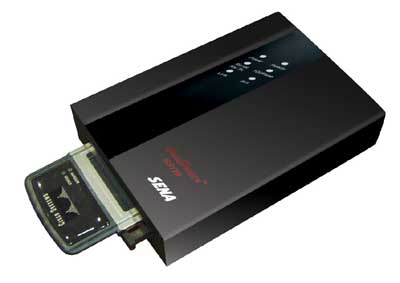Device Profile: Sena HelloDevice serial-ethernet converter
Aug 14, 2003 — by LinuxDevices Staff — from the LinuxDevices Archive — 2 viewsSena Technologies' HelloDevice SS110 is a small serial-Ethernet converter with a wealth of network connection options thanks to the flexibility of a PCMCIA interface and a built-in wireless interface. Paired with Sena Technologies' HelloDevice visual integrated development environment (IDE), the SS110 can serve as part of a custom remote… management, monitoring, or control solution.

With support for PPPoE and a Dynamic DNS client, the HelloDevice is well-suited to accessing serial devices via broadband DSL connections, even those with impermanent IP addresses. The DynDNS client interfaces with any of a number of companies offering Dynamic DNS services, updating the device's hostname as required.
Typical applications for the HelloDevice SS110 include out-of-band network management, industrial automation and control, retail automation/point-of-sale, remote metering, remote display, building automation, security/access control systems, medical automation, general data acquisition and connecting various types of serially-interfaced devices to networks.
Sena's HelloDevice visual IDE can be used to develop Java applets and applications for controlling, monitoring, or generally communicating with serial devices attached to the SS110.
Given the security implications of putting serial devices such as manufacturing equipment or telecommunications equipment online, the HelloDevice offers IP address filtering and public key cryptography based on SSL data encryption, RC4 and 3DES.
The device's PCMCIA slot can be used to add LAN or Wireless LAN cards, PSTN or CDMA cards for out-of-band access, or Flash/ATA Memory cards to keep system log and port log data safely.
The HelloDevice has no display or display interface, but can be configured or accessed through a password-protected Web interface, a secure shell, telnet, or a serial console. Management functions include a status monitor, remote reset, error log monitor and firmware upgrade. Management and configuration software is included with the device.
Under the Hood
An MPC855T 32-bit RISC processor running at 50MHz forms the core of the HelloDevice, which boots from an 8MB DiskOnChip into 32MB of RAM. In addition to its wireless interface, serial port and PCMCIA slot, the device contains a modem port. A DB9 connector attaches the SS110 to RS232/422/485 based serial devices with data transfer rates up to 230Kbps.
Running a 2.4.2 Linux kernel, the HelloDevice includes the GoAhead web server, OpenSSL, NFS, SYSLOG, and an SMTP client supporting SNMP v1 and v2 protocols. The Linux environment offers easy customization through scripts and libraries.
Sena Technologies says it chose Linux for the project due to the flexibility of open source. It was satisfied with its choice to use Linux, and plans to develop products in the future using embedded Linux. Sena does its own Linux implementation and integration, and faced challenges integrating drivers such as the PCMCIA system.
This article was originally published on LinuxDevices.com and has been donated to the open source community by QuinStreet Inc. Please visit LinuxToday.com for up-to-date news and articles about Linux and open source.